Leadership and Organisational Dynamics: A Thomas Cook Analysis
VerifiedAdded on 2023/01/10
|12
|3863
|59
Report
AI Summary
This report provides a comprehensive analysis of Thomas Cook's organisational theory and practice. It begins with an introduction to the company and its CEO, Peter Fankhauser, highlighting his charismatic leadership. The report then delves into the management styles employed, focusing on participative management and its impact on employee motivation and creativity. It examines the organisational structure, specifically the functional structure, and proposes steps to enhance performance, including clear authority and communication channels. Furthermore, the report explores Thomas Cook's organisational culture using Handy's model, examining the impacts on employees. The leadership style of the CEO, primarily transformational leadership, is discussed, along with its role in organisational effectiveness. The analysis extends to the effects of power, influence, and conflicts, using a channel power model. Various motivation techniques employed by the company are also examined. The report concludes with recommendations based on the findings and includes references to support the analysis, offering insights into how Thomas Cook operates and manages its workforce.
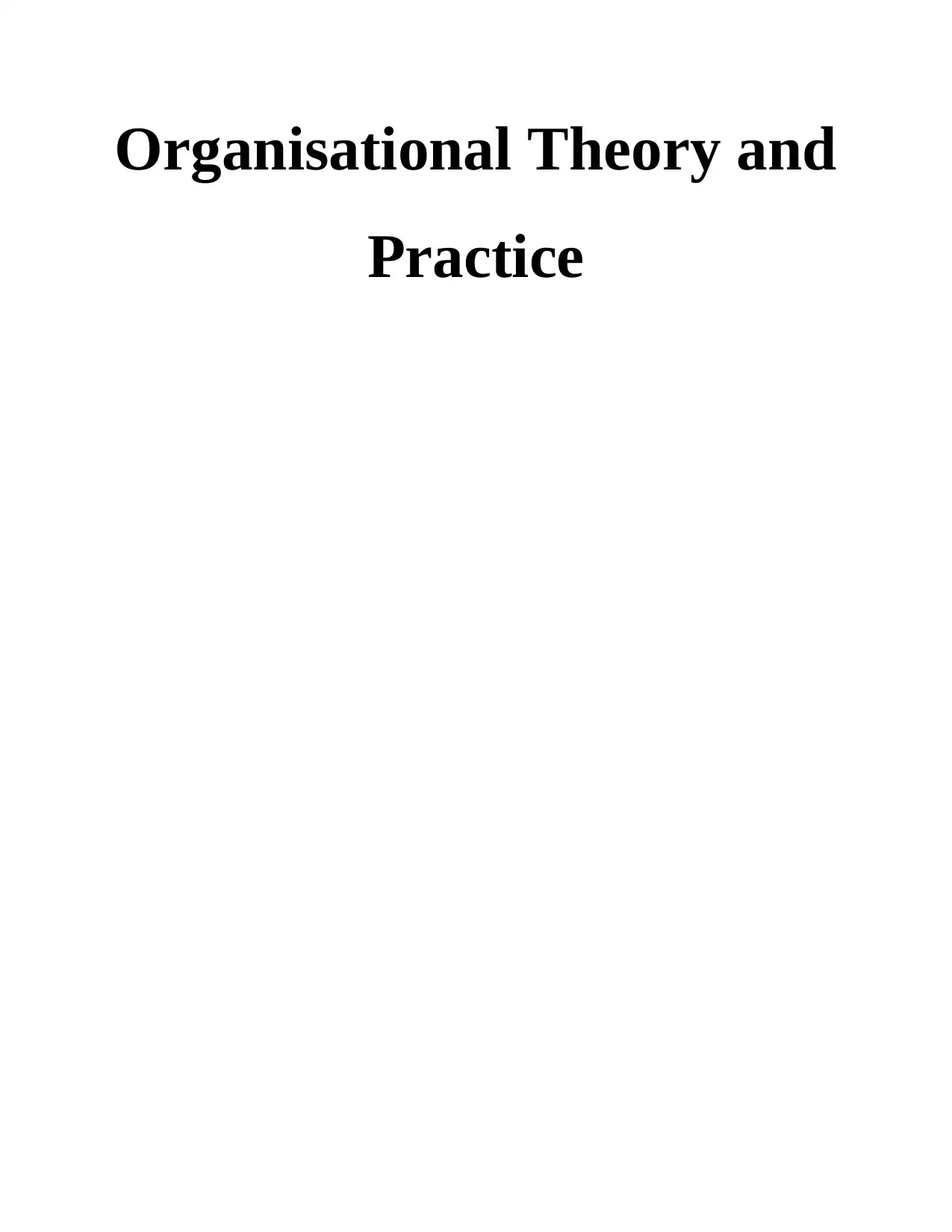
Organisational Theory and
Practice
Practice
Paraphrase This Document
Need a fresh take? Get an instant paraphrase of this document with our AI Paraphraser
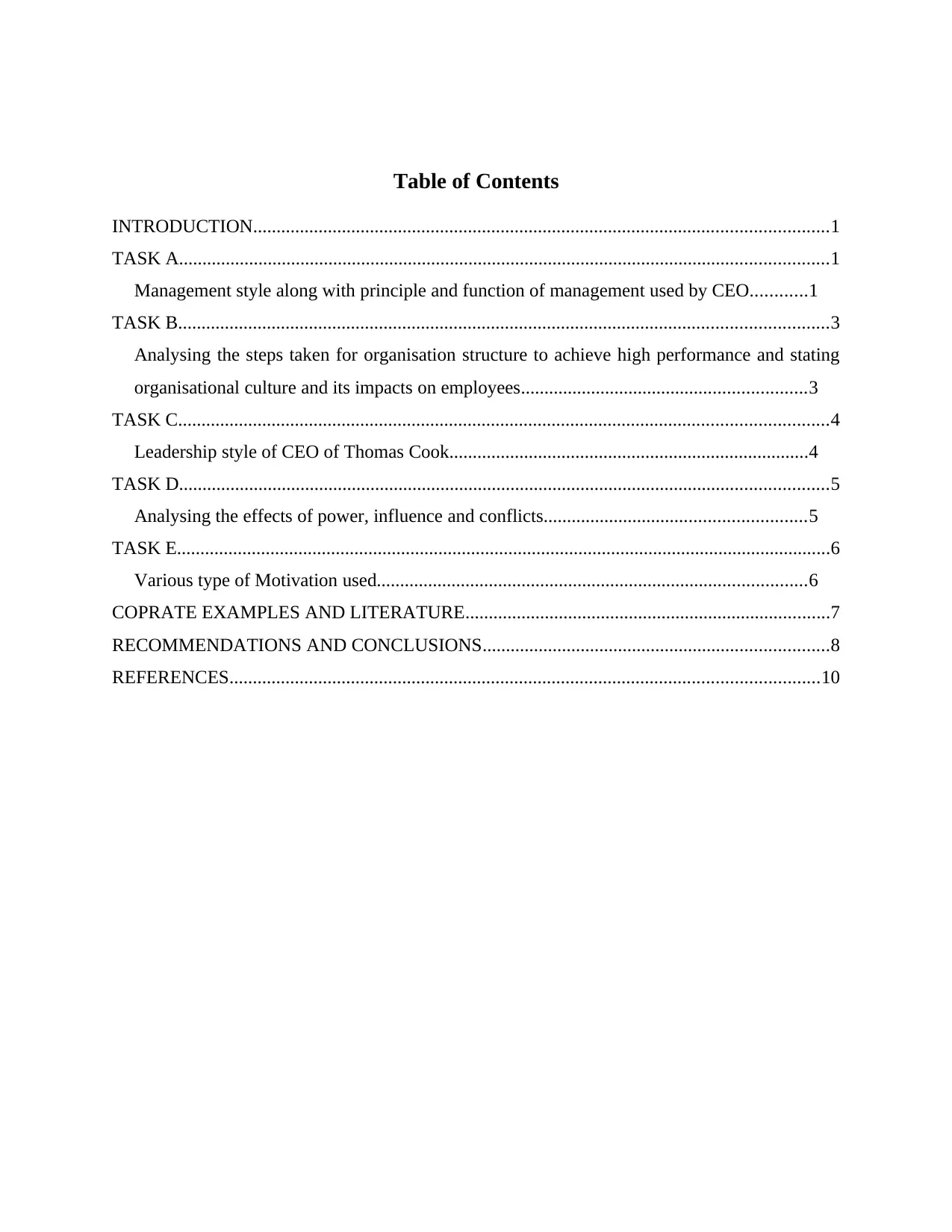
Table of Contents
INTRODUCTION...........................................................................................................................1
TASK A...........................................................................................................................................1
Management style along with principle and function of management used by CEO............1
TASK B...........................................................................................................................................3
Analysing the steps taken for organisation structure to achieve high performance and stating
organisational culture and its impacts on employees.............................................................3
TASK C...........................................................................................................................................4
Leadership style of CEO of Thomas Cook.............................................................................4
TASK D...........................................................................................................................................5
Analysing the effects of power, influence and conflicts........................................................5
TASK E............................................................................................................................................6
Various type of Motivation used............................................................................................6
COPRATE EXAMPLES AND LITERATURE..............................................................................7
RECOMMENDATIONS AND CONCLUSIONS..........................................................................8
REFERENCES..............................................................................................................................10
INTRODUCTION...........................................................................................................................1
TASK A...........................................................................................................................................1
Management style along with principle and function of management used by CEO............1
TASK B...........................................................................................................................................3
Analysing the steps taken for organisation structure to achieve high performance and stating
organisational culture and its impacts on employees.............................................................3
TASK C...........................................................................................................................................4
Leadership style of CEO of Thomas Cook.............................................................................4
TASK D...........................................................................................................................................5
Analysing the effects of power, influence and conflicts........................................................5
TASK E............................................................................................................................................6
Various type of Motivation used............................................................................................6
COPRATE EXAMPLES AND LITERATURE..............................................................................7
RECOMMENDATIONS AND CONCLUSIONS..........................................................................8
REFERENCES..............................................................................................................................10
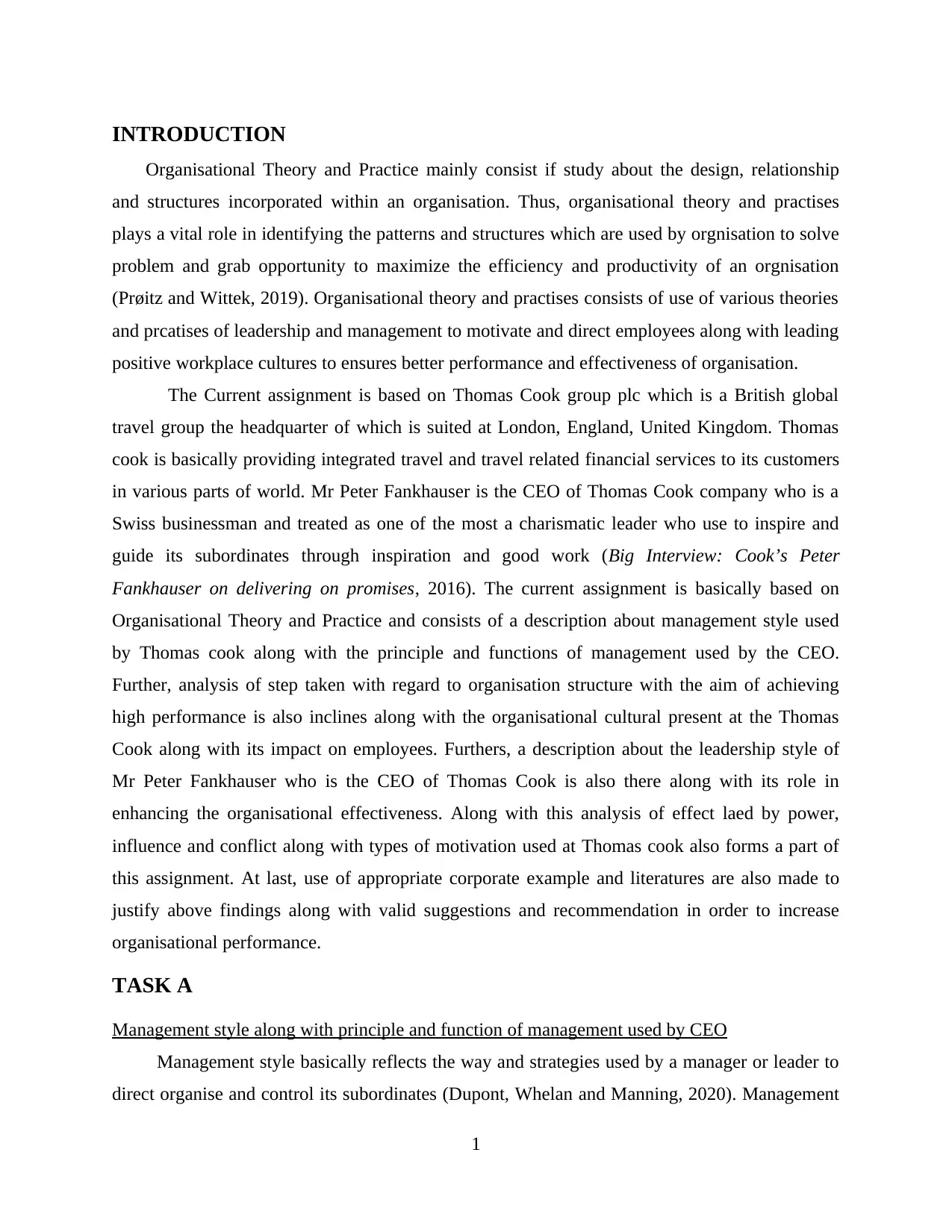
INTRODUCTION
Organisational Theory and Practice mainly consist if study about the design, relationship
and structures incorporated within an organisation. Thus, organisational theory and practises
plays a vital role in identifying the patterns and structures which are used by orgnisation to solve
problem and grab opportunity to maximize the efficiency and productivity of an orgnisation
(Prøitz and Wittek, 2019). Organisational theory and practises consists of use of various theories
and prcatises of leadership and management to motivate and direct employees along with leading
positive workplace cultures to ensures better performance and effectiveness of organisation.
The Current assignment is based on Thomas Cook group plc which is a British global
travel group the headquarter of which is suited at London, England, United Kingdom. Thomas
cook is basically providing integrated travel and travel related financial services to its customers
in various parts of world. Mr Peter Fankhauser is the CEO of Thomas Cook company who is a
Swiss businessman and treated as one of the most a charismatic leader who use to inspire and
guide its subordinates through inspiration and good work (Big Interview: Cook’s Peter
Fankhauser on delivering on promises, 2016). The current assignment is basically based on
Organisational Theory and Practice and consists of a description about management style used
by Thomas cook along with the principle and functions of management used by the CEO.
Further, analysis of step taken with regard to organisation structure with the aim of achieving
high performance is also inclines along with the organisational cultural present at the Thomas
Cook along with its impact on employees. Furthers, a description about the leadership style of
Mr Peter Fankhauser who is the CEO of Thomas Cook is also there along with its role in
enhancing the organisational effectiveness. Along with this analysis of effect laed by power,
influence and conflict along with types of motivation used at Thomas cook also forms a part of
this assignment. At last, use of appropriate corporate example and literatures are also made to
justify above findings along with valid suggestions and recommendation in order to increase
organisational performance.
TASK A
Management style along with principle and function of management used by CEO
Management style basically reflects the way and strategies used by a manager or leader to
direct organise and control its subordinates (Dupont, Whelan and Manning, 2020). Management
1
Organisational Theory and Practice mainly consist if study about the design, relationship
and structures incorporated within an organisation. Thus, organisational theory and practises
plays a vital role in identifying the patterns and structures which are used by orgnisation to solve
problem and grab opportunity to maximize the efficiency and productivity of an orgnisation
(Prøitz and Wittek, 2019). Organisational theory and practises consists of use of various theories
and prcatises of leadership and management to motivate and direct employees along with leading
positive workplace cultures to ensures better performance and effectiveness of organisation.
The Current assignment is based on Thomas Cook group plc which is a British global
travel group the headquarter of which is suited at London, England, United Kingdom. Thomas
cook is basically providing integrated travel and travel related financial services to its customers
in various parts of world. Mr Peter Fankhauser is the CEO of Thomas Cook company who is a
Swiss businessman and treated as one of the most a charismatic leader who use to inspire and
guide its subordinates through inspiration and good work (Big Interview: Cook’s Peter
Fankhauser on delivering on promises, 2016). The current assignment is basically based on
Organisational Theory and Practice and consists of a description about management style used
by Thomas cook along with the principle and functions of management used by the CEO.
Further, analysis of step taken with regard to organisation structure with the aim of achieving
high performance is also inclines along with the organisational cultural present at the Thomas
Cook along with its impact on employees. Furthers, a description about the leadership style of
Mr Peter Fankhauser who is the CEO of Thomas Cook is also there along with its role in
enhancing the organisational effectiveness. Along with this analysis of effect laed by power,
influence and conflict along with types of motivation used at Thomas cook also forms a part of
this assignment. At last, use of appropriate corporate example and literatures are also made to
justify above findings along with valid suggestions and recommendation in order to increase
organisational performance.
TASK A
Management style along with principle and function of management used by CEO
Management style basically reflects the way and strategies used by a manager or leader to
direct organise and control its subordinates (Dupont, Whelan and Manning, 2020). Management
1
⊘ This is a preview!⊘
Do you want full access?
Subscribe today to unlock all pages.

Trusted by 1+ million students worldwide
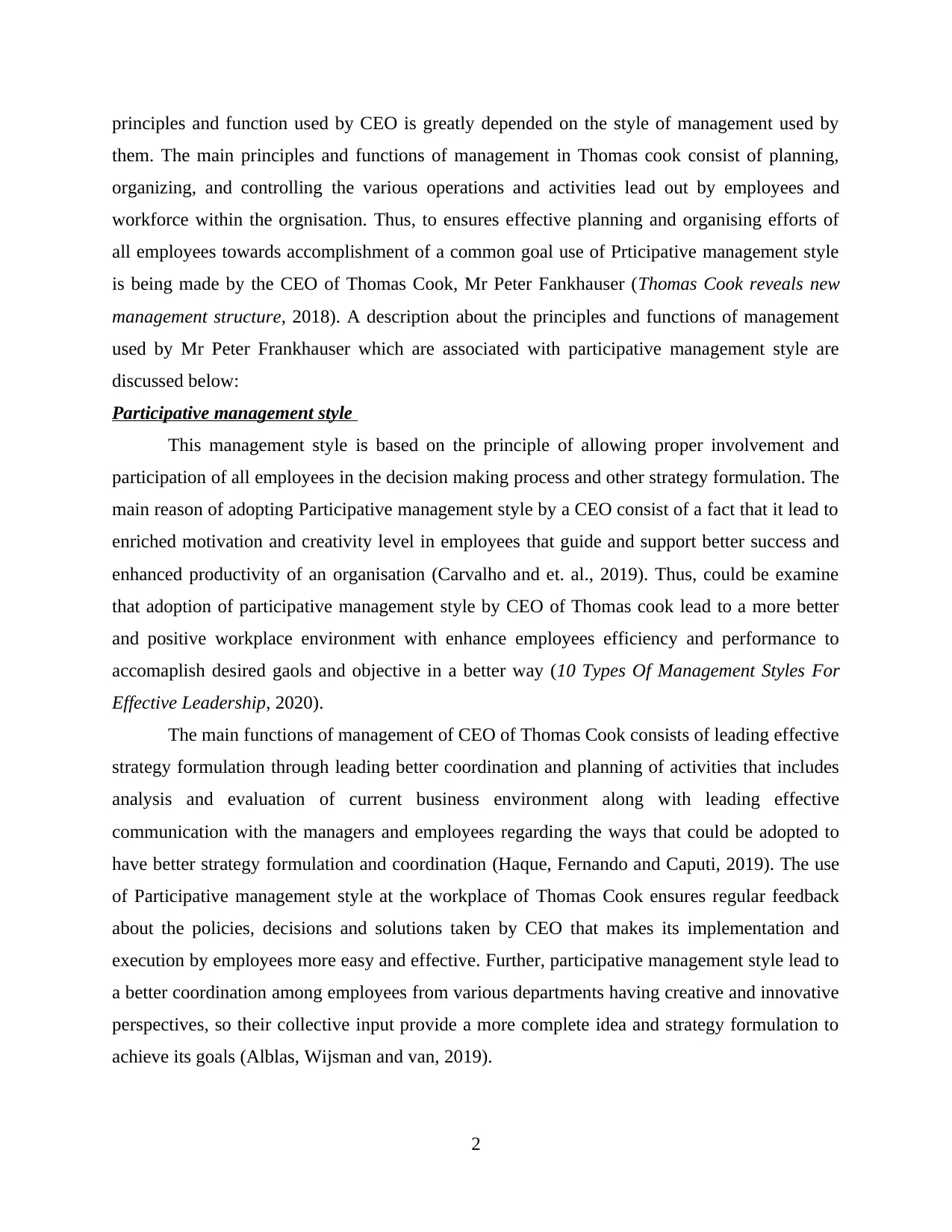
principles and function used by CEO is greatly depended on the style of management used by
them. The main principles and functions of management in Thomas cook consist of planning,
organizing, and controlling the various operations and activities lead out by employees and
workforce within the orgnisation. Thus, to ensures effective planning and organising efforts of
all employees towards accomplishment of a common goal use of Prticipative management style
is being made by the CEO of Thomas Cook, Mr Peter Fankhauser (Thomas Cook reveals new
management structure, 2018). A description about the principles and functions of management
used by Mr Peter Frankhauser which are associated with participative management style are
discussed below:
Participative management style
This management style is based on the principle of allowing proper involvement and
participation of all employees in the decision making process and other strategy formulation. The
main reason of adopting Participative management style by a CEO consist of a fact that it lead to
enriched motivation and creativity level in employees that guide and support better success and
enhanced productivity of an organisation (Carvalho and et. al., 2019). Thus, could be examine
that adoption of participative management style by CEO of Thomas cook lead to a more better
and positive workplace environment with enhance employees efficiency and performance to
accomaplish desired gaols and objective in a better way (10 Types Of Management Styles For
Effective Leadership, 2020).
The main functions of management of CEO of Thomas Cook consists of leading effective
strategy formulation through leading better coordination and planning of activities that includes
analysis and evaluation of current business environment along with leading effective
communication with the managers and employees regarding the ways that could be adopted to
have better strategy formulation and coordination (Haque, Fernando and Caputi, 2019). The use
of Participative management style at the workplace of Thomas Cook ensures regular feedback
about the policies, decisions and solutions taken by CEO that makes its implementation and
execution by employees more easy and effective. Further, participative management style lead to
a better coordination among employees from various departments having creative and innovative
perspectives, so their collective input provide a more complete idea and strategy formulation to
achieve its goals (Alblas, Wijsman and van, 2019).
2
them. The main principles and functions of management in Thomas cook consist of planning,
organizing, and controlling the various operations and activities lead out by employees and
workforce within the orgnisation. Thus, to ensures effective planning and organising efforts of
all employees towards accomplishment of a common goal use of Prticipative management style
is being made by the CEO of Thomas Cook, Mr Peter Fankhauser (Thomas Cook reveals new
management structure, 2018). A description about the principles and functions of management
used by Mr Peter Frankhauser which are associated with participative management style are
discussed below:
Participative management style
This management style is based on the principle of allowing proper involvement and
participation of all employees in the decision making process and other strategy formulation. The
main reason of adopting Participative management style by a CEO consist of a fact that it lead to
enriched motivation and creativity level in employees that guide and support better success and
enhanced productivity of an organisation (Carvalho and et. al., 2019). Thus, could be examine
that adoption of participative management style by CEO of Thomas cook lead to a more better
and positive workplace environment with enhance employees efficiency and performance to
accomaplish desired gaols and objective in a better way (10 Types Of Management Styles For
Effective Leadership, 2020).
The main functions of management of CEO of Thomas Cook consists of leading effective
strategy formulation through leading better coordination and planning of activities that includes
analysis and evaluation of current business environment along with leading effective
communication with the managers and employees regarding the ways that could be adopted to
have better strategy formulation and coordination (Haque, Fernando and Caputi, 2019). The use
of Participative management style at the workplace of Thomas Cook ensures regular feedback
about the policies, decisions and solutions taken by CEO that makes its implementation and
execution by employees more easy and effective. Further, participative management style lead to
a better coordination among employees from various departments having creative and innovative
perspectives, so their collective input provide a more complete idea and strategy formulation to
achieve its goals (Alblas, Wijsman and van, 2019).
2
Paraphrase This Document
Need a fresh take? Get an instant paraphrase of this document with our AI Paraphraser
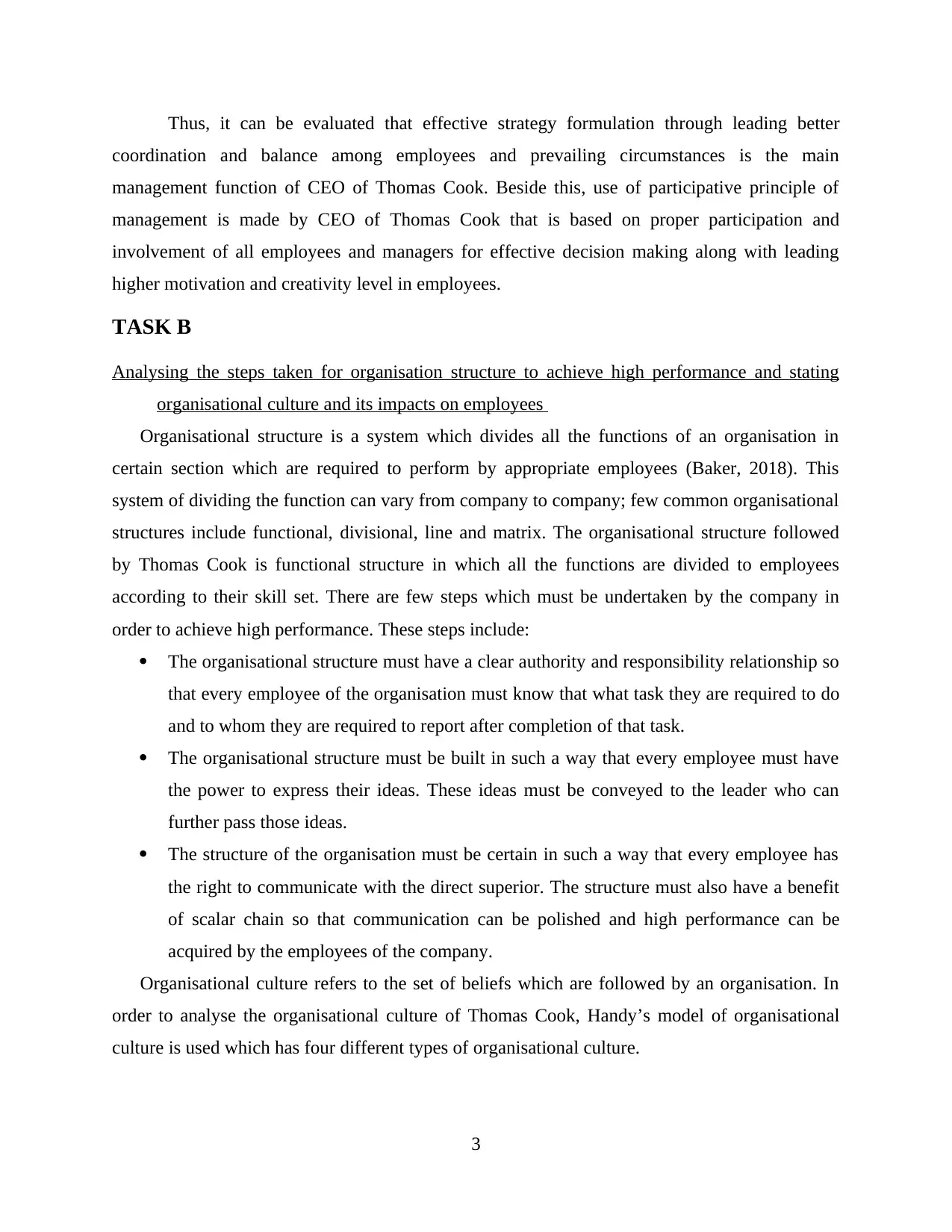
Thus, it can be evaluated that effective strategy formulation through leading better
coordination and balance among employees and prevailing circumstances is the main
management function of CEO of Thomas Cook. Beside this, use of participative principle of
management is made by CEO of Thomas Cook that is based on proper participation and
involvement of all employees and managers for effective decision making along with leading
higher motivation and creativity level in employees.
TASK B
Analysing the steps taken for organisation structure to achieve high performance and stating
organisational culture and its impacts on employees
Organisational structure is a system which divides all the functions of an organisation in
certain section which are required to perform by appropriate employees (Baker, 2018). This
system of dividing the function can vary from company to company; few common organisational
structures include functional, divisional, line and matrix. The organisational structure followed
by Thomas Cook is functional structure in which all the functions are divided to employees
according to their skill set. There are few steps which must be undertaken by the company in
order to achieve high performance. These steps include:
The organisational structure must have a clear authority and responsibility relationship so
that every employee of the organisation must know that what task they are required to do
and to whom they are required to report after completion of that task.
The organisational structure must be built in such a way that every employee must have
the power to express their ideas. These ideas must be conveyed to the leader who can
further pass those ideas.
The structure of the organisation must be certain in such a way that every employee has
the right to communicate with the direct superior. The structure must also have a benefit
of scalar chain so that communication can be polished and high performance can be
acquired by the employees of the company.
Organisational culture refers to the set of beliefs which are followed by an organisation. In
order to analyse the organisational culture of Thomas Cook, Handy’s model of organisational
culture is used which has four different types of organisational culture.
3
coordination and balance among employees and prevailing circumstances is the main
management function of CEO of Thomas Cook. Beside this, use of participative principle of
management is made by CEO of Thomas Cook that is based on proper participation and
involvement of all employees and managers for effective decision making along with leading
higher motivation and creativity level in employees.
TASK B
Analysing the steps taken for organisation structure to achieve high performance and stating
organisational culture and its impacts on employees
Organisational structure is a system which divides all the functions of an organisation in
certain section which are required to perform by appropriate employees (Baker, 2018). This
system of dividing the function can vary from company to company; few common organisational
structures include functional, divisional, line and matrix. The organisational structure followed
by Thomas Cook is functional structure in which all the functions are divided to employees
according to their skill set. There are few steps which must be undertaken by the company in
order to achieve high performance. These steps include:
The organisational structure must have a clear authority and responsibility relationship so
that every employee of the organisation must know that what task they are required to do
and to whom they are required to report after completion of that task.
The organisational structure must be built in such a way that every employee must have
the power to express their ideas. These ideas must be conveyed to the leader who can
further pass those ideas.
The structure of the organisation must be certain in such a way that every employee has
the right to communicate with the direct superior. The structure must also have a benefit
of scalar chain so that communication can be polished and high performance can be
acquired by the employees of the company.
Organisational culture refers to the set of beliefs which are followed by an organisation. In
order to analyse the organisational culture of Thomas Cook, Handy’s model of organisational
culture is used which has four different types of organisational culture.
3
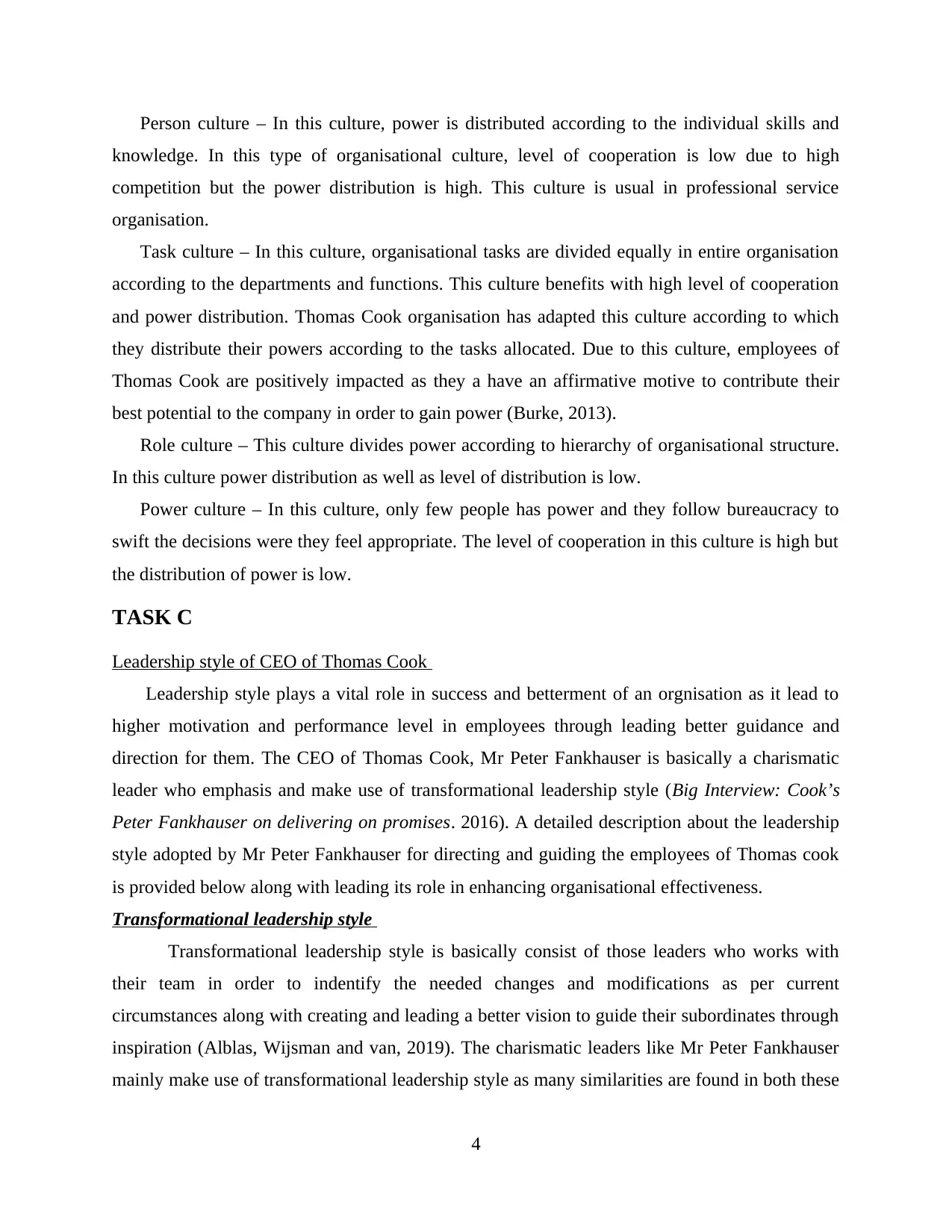
Person culture – In this culture, power is distributed according to the individual skills and
knowledge. In this type of organisational culture, level of cooperation is low due to high
competition but the power distribution is high. This culture is usual in professional service
organisation.
Task culture – In this culture, organisational tasks are divided equally in entire organisation
according to the departments and functions. This culture benefits with high level of cooperation
and power distribution. Thomas Cook organisation has adapted this culture according to which
they distribute their powers according to the tasks allocated. Due to this culture, employees of
Thomas Cook are positively impacted as they a have an affirmative motive to contribute their
best potential to the company in order to gain power (Burke, 2013).
Role culture – This culture divides power according to hierarchy of organisational structure.
In this culture power distribution as well as level of distribution is low.
Power culture – In this culture, only few people has power and they follow bureaucracy to
swift the decisions were they feel appropriate. The level of cooperation in this culture is high but
the distribution of power is low.
TASK C
Leadership style of CEO of Thomas Cook
Leadership style plays a vital role in success and betterment of an orgnisation as it lead to
higher motivation and performance level in employees through leading better guidance and
direction for them. The CEO of Thomas Cook, Mr Peter Fankhauser is basically a charismatic
leader who emphasis and make use of transformational leadership style (Big Interview: Cook’s
Peter Fankhauser on delivering on promises. 2016). A detailed description about the leadership
style adopted by Mr Peter Fankhauser for directing and guiding the employees of Thomas cook
is provided below along with leading its role in enhancing organisational effectiveness.
Transformational leadership style
Transformational leadership style is basically consist of those leaders who works with
their team in order to indentify the needed changes and modifications as per current
circumstances along with creating and leading a better vision to guide their subordinates through
inspiration (Alblas, Wijsman and van, 2019). The charismatic leaders like Mr Peter Fankhauser
mainly make use of transformational leadership style as many similarities are found in both these
4
knowledge. In this type of organisational culture, level of cooperation is low due to high
competition but the power distribution is high. This culture is usual in professional service
organisation.
Task culture – In this culture, organisational tasks are divided equally in entire organisation
according to the departments and functions. This culture benefits with high level of cooperation
and power distribution. Thomas Cook organisation has adapted this culture according to which
they distribute their powers according to the tasks allocated. Due to this culture, employees of
Thomas Cook are positively impacted as they a have an affirmative motive to contribute their
best potential to the company in order to gain power (Burke, 2013).
Role culture – This culture divides power according to hierarchy of organisational structure.
In this culture power distribution as well as level of distribution is low.
Power culture – In this culture, only few people has power and they follow bureaucracy to
swift the decisions were they feel appropriate. The level of cooperation in this culture is high but
the distribution of power is low.
TASK C
Leadership style of CEO of Thomas Cook
Leadership style plays a vital role in success and betterment of an orgnisation as it lead to
higher motivation and performance level in employees through leading better guidance and
direction for them. The CEO of Thomas Cook, Mr Peter Fankhauser is basically a charismatic
leader who emphasis and make use of transformational leadership style (Big Interview: Cook’s
Peter Fankhauser on delivering on promises. 2016). A detailed description about the leadership
style adopted by Mr Peter Fankhauser for directing and guiding the employees of Thomas cook
is provided below along with leading its role in enhancing organisational effectiveness.
Transformational leadership style
Transformational leadership style is basically consist of those leaders who works with
their team in order to indentify the needed changes and modifications as per current
circumstances along with creating and leading a better vision to guide their subordinates through
inspiration (Alblas, Wijsman and van, 2019). The charismatic leaders like Mr Peter Fankhauser
mainly make use of transformational leadership style as many similarities are found in both these
4
⊘ This is a preview!⊘
Do you want full access?
Subscribe today to unlock all pages.

Trusted by 1+ million students worldwide
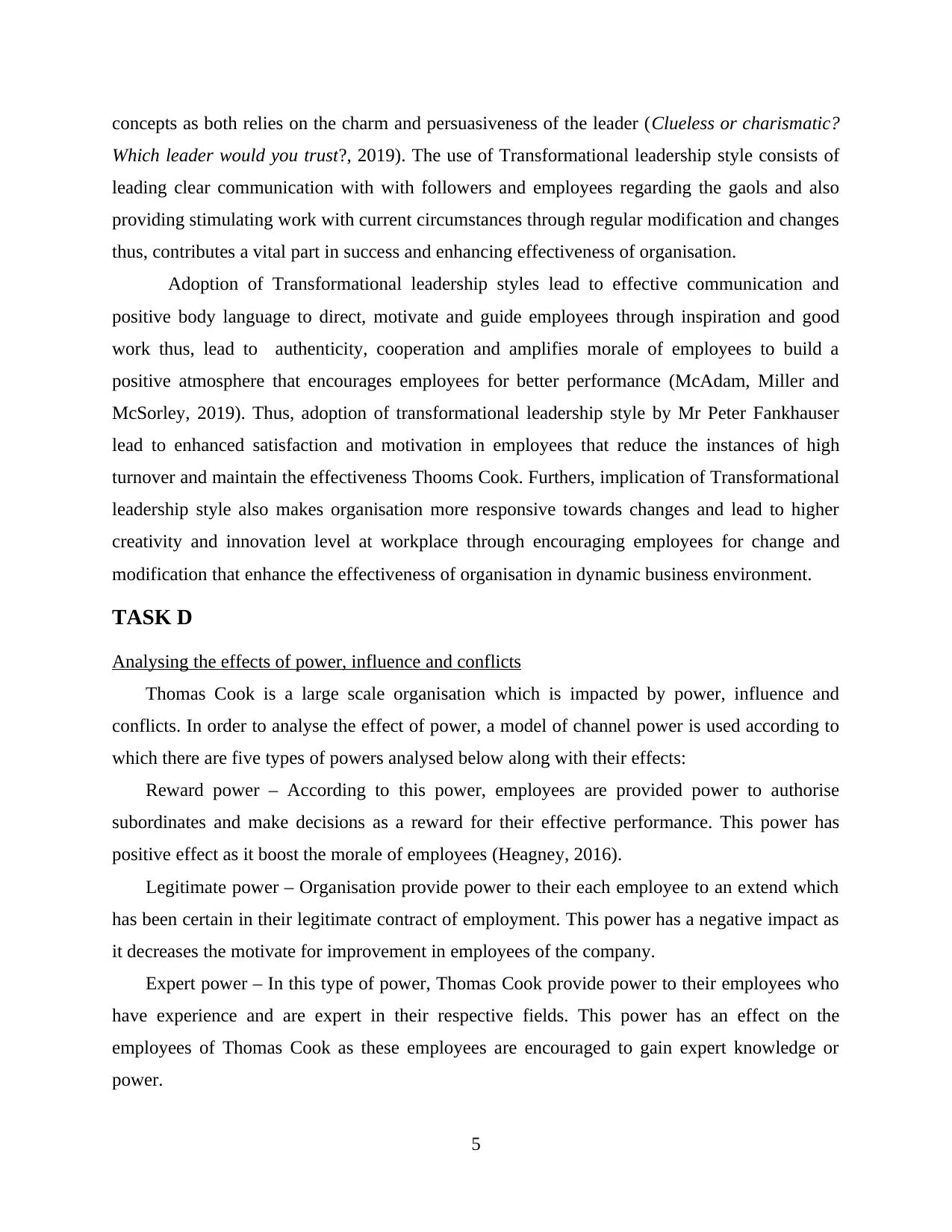
concepts as both relies on the charm and persuasiveness of the leader (Clueless or charismatic?
Which leader would you trust?, 2019). The use of Transformational leadership style consists of
leading clear communication with with followers and employees regarding the gaols and also
providing stimulating work with current circumstances through regular modification and changes
thus, contributes a vital part in success and enhancing effectiveness of organisation.
Adoption of Transformational leadership styles lead to effective communication and
positive body language to direct, motivate and guide employees through inspiration and good
work thus, lead to authenticity, cooperation and amplifies morale of employees to build a
positive atmosphere that encourages employees for better performance (McAdam, Miller and
McSorley, 2019). Thus, adoption of transformational leadership style by Mr Peter Fankhauser
lead to enhanced satisfaction and motivation in employees that reduce the instances of high
turnover and maintain the effectiveness Thooms Cook. Furthers, implication of Transformational
leadership style also makes organisation more responsive towards changes and lead to higher
creativity and innovation level at workplace through encouraging employees for change and
modification that enhance the effectiveness of organisation in dynamic business environment.
TASK D
Analysing the effects of power, influence and conflicts
Thomas Cook is a large scale organisation which is impacted by power, influence and
conflicts. In order to analyse the effect of power, a model of channel power is used according to
which there are five types of powers analysed below along with their effects:
Reward power – According to this power, employees are provided power to authorise
subordinates and make decisions as a reward for their effective performance. This power has
positive effect as it boost the morale of employees (Heagney, 2016).
Legitimate power – Organisation provide power to their each employee to an extend which
has been certain in their legitimate contract of employment. This power has a negative impact as
it decreases the motivate for improvement in employees of the company.
Expert power – In this type of power, Thomas Cook provide power to their employees who
have experience and are expert in their respective fields. This power has an effect on the
employees of Thomas Cook as these employees are encouraged to gain expert knowledge or
power.
5
Which leader would you trust?, 2019). The use of Transformational leadership style consists of
leading clear communication with with followers and employees regarding the gaols and also
providing stimulating work with current circumstances through regular modification and changes
thus, contributes a vital part in success and enhancing effectiveness of organisation.
Adoption of Transformational leadership styles lead to effective communication and
positive body language to direct, motivate and guide employees through inspiration and good
work thus, lead to authenticity, cooperation and amplifies morale of employees to build a
positive atmosphere that encourages employees for better performance (McAdam, Miller and
McSorley, 2019). Thus, adoption of transformational leadership style by Mr Peter Fankhauser
lead to enhanced satisfaction and motivation in employees that reduce the instances of high
turnover and maintain the effectiveness Thooms Cook. Furthers, implication of Transformational
leadership style also makes organisation more responsive towards changes and lead to higher
creativity and innovation level at workplace through encouraging employees for change and
modification that enhance the effectiveness of organisation in dynamic business environment.
TASK D
Analysing the effects of power, influence and conflicts
Thomas Cook is a large scale organisation which is impacted by power, influence and
conflicts. In order to analyse the effect of power, a model of channel power is used according to
which there are five types of powers analysed below along with their effects:
Reward power – According to this power, employees are provided power to authorise
subordinates and make decisions as a reward for their effective performance. This power has
positive effect as it boost the morale of employees (Heagney, 2016).
Legitimate power – Organisation provide power to their each employee to an extend which
has been certain in their legitimate contract of employment. This power has a negative impact as
it decreases the motivate for improvement in employees of the company.
Expert power – In this type of power, Thomas Cook provide power to their employees who
have experience and are expert in their respective fields. This power has an effect on the
employees of Thomas Cook as these employees are encouraged to gain expert knowledge or
power.
5
Paraphrase This Document
Need a fresh take? Get an instant paraphrase of this document with our AI Paraphraser
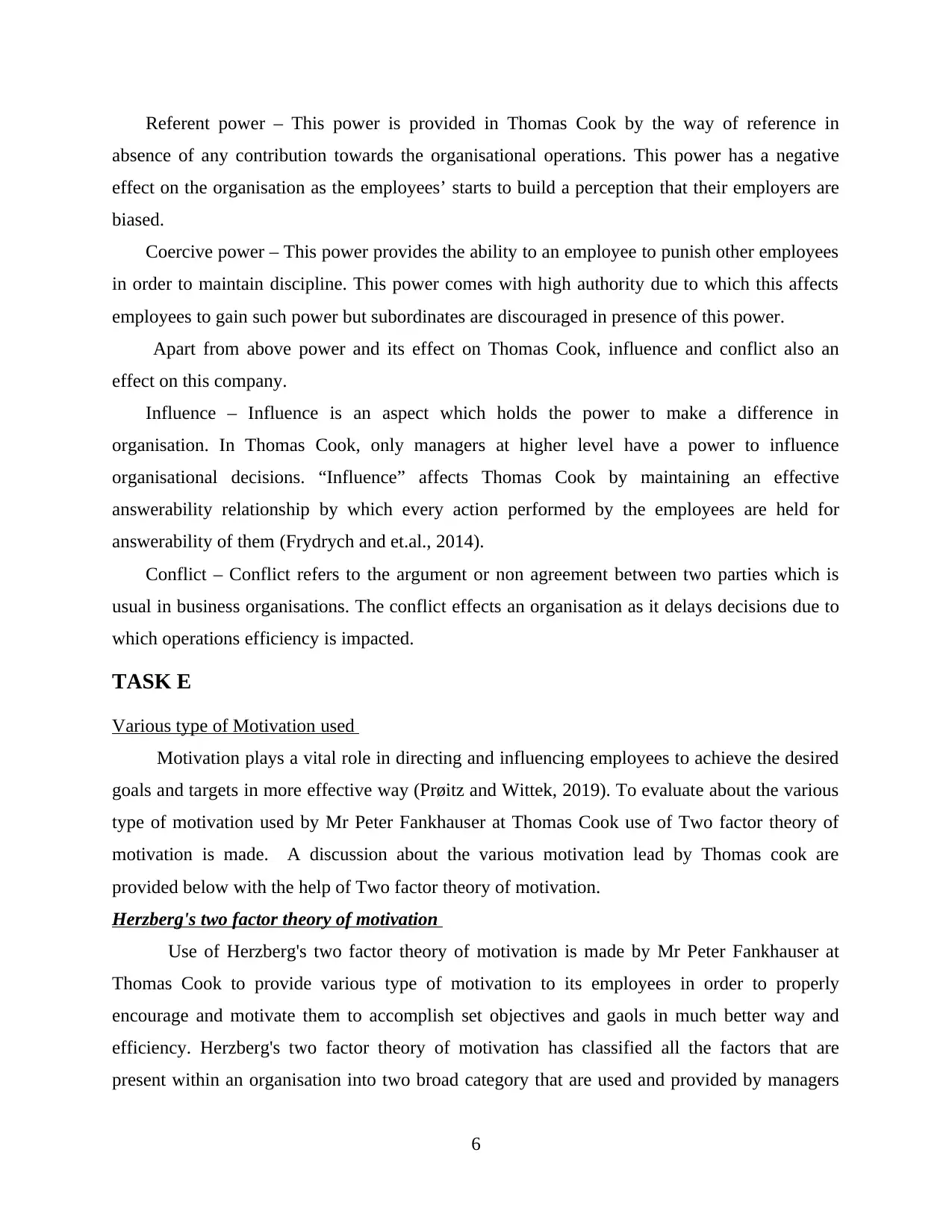
Referent power – This power is provided in Thomas Cook by the way of reference in
absence of any contribution towards the organisational operations. This power has a negative
effect on the organisation as the employees’ starts to build a perception that their employers are
biased.
Coercive power – This power provides the ability to an employee to punish other employees
in order to maintain discipline. This power comes with high authority due to which this affects
employees to gain such power but subordinates are discouraged in presence of this power.
Apart from above power and its effect on Thomas Cook, influence and conflict also an
effect on this company.
Influence – Influence is an aspect which holds the power to make a difference in
organisation. In Thomas Cook, only managers at higher level have a power to influence
organisational decisions. “Influence” affects Thomas Cook by maintaining an effective
answerability relationship by which every action performed by the employees are held for
answerability of them (Frydrych and et.al., 2014).
Conflict – Conflict refers to the argument or non agreement between two parties which is
usual in business organisations. The conflict effects an organisation as it delays decisions due to
which operations efficiency is impacted.
TASK E
Various type of Motivation used
Motivation plays a vital role in directing and influencing employees to achieve the desired
goals and targets in more effective way (Prøitz and Wittek, 2019). To evaluate about the various
type of motivation used by Mr Peter Fankhauser at Thomas Cook use of Two factor theory of
motivation is made. A discussion about the various motivation lead by Thomas cook are
provided below with the help of Two factor theory of motivation.
Herzberg's two factor theory of motivation
Use of Herzberg's two factor theory of motivation is made by Mr Peter Fankhauser at
Thomas Cook to provide various type of motivation to its employees in order to properly
encourage and motivate them to accomplish set objectives and gaols in much better way and
efficiency. Herzberg's two factor theory of motivation has classified all the factors that are
present within an organisation into two broad category that are used and provided by managers
6
absence of any contribution towards the organisational operations. This power has a negative
effect on the organisation as the employees’ starts to build a perception that their employers are
biased.
Coercive power – This power provides the ability to an employee to punish other employees
in order to maintain discipline. This power comes with high authority due to which this affects
employees to gain such power but subordinates are discouraged in presence of this power.
Apart from above power and its effect on Thomas Cook, influence and conflict also an
effect on this company.
Influence – Influence is an aspect which holds the power to make a difference in
organisation. In Thomas Cook, only managers at higher level have a power to influence
organisational decisions. “Influence” affects Thomas Cook by maintaining an effective
answerability relationship by which every action performed by the employees are held for
answerability of them (Frydrych and et.al., 2014).
Conflict – Conflict refers to the argument or non agreement between two parties which is
usual in business organisations. The conflict effects an organisation as it delays decisions due to
which operations efficiency is impacted.
TASK E
Various type of Motivation used
Motivation plays a vital role in directing and influencing employees to achieve the desired
goals and targets in more effective way (Prøitz and Wittek, 2019). To evaluate about the various
type of motivation used by Mr Peter Fankhauser at Thomas Cook use of Two factor theory of
motivation is made. A discussion about the various motivation lead by Thomas cook are
provided below with the help of Two factor theory of motivation.
Herzberg's two factor theory of motivation
Use of Herzberg's two factor theory of motivation is made by Mr Peter Fankhauser at
Thomas Cook to provide various type of motivation to its employees in order to properly
encourage and motivate them to accomplish set objectives and gaols in much better way and
efficiency. Herzberg's two factor theory of motivation has classified all the factors that are
present within an organisation into two broad category that are used and provided by managers
6
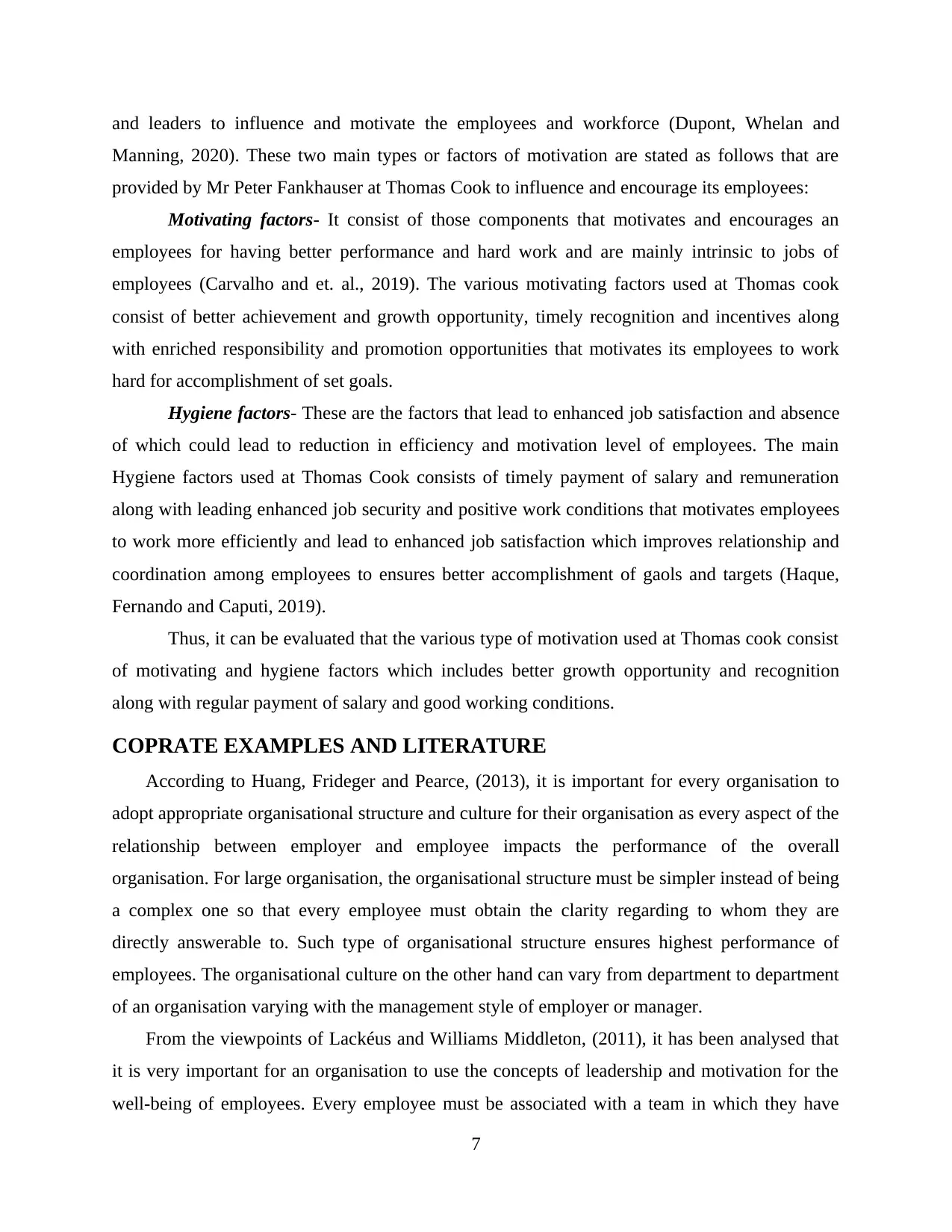
and leaders to influence and motivate the employees and workforce (Dupont, Whelan and
Manning, 2020). These two main types or factors of motivation are stated as follows that are
provided by Mr Peter Fankhauser at Thomas Cook to influence and encourage its employees:
Motivating factors- It consist of those components that motivates and encourages an
employees for having better performance and hard work and are mainly intrinsic to jobs of
employees (Carvalho and et. al., 2019). The various motivating factors used at Thomas cook
consist of better achievement and growth opportunity, timely recognition and incentives along
with enriched responsibility and promotion opportunities that motivates its employees to work
hard for accomplishment of set goals.
Hygiene factors- These are the factors that lead to enhanced job satisfaction and absence
of which could lead to reduction in efficiency and motivation level of employees. The main
Hygiene factors used at Thomas Cook consists of timely payment of salary and remuneration
along with leading enhanced job security and positive work conditions that motivates employees
to work more efficiently and lead to enhanced job satisfaction which improves relationship and
coordination among employees to ensures better accomplishment of gaols and targets (Haque,
Fernando and Caputi, 2019).
Thus, it can be evaluated that the various type of motivation used at Thomas cook consist
of motivating and hygiene factors which includes better growth opportunity and recognition
along with regular payment of salary and good working conditions.
COPRATE EXAMPLES AND LITERATURE
According to Huang, Frideger and Pearce, (2013), it is important for every organisation to
adopt appropriate organisational structure and culture for their organisation as every aspect of the
relationship between employer and employee impacts the performance of the overall
organisation. For large organisation, the organisational structure must be simpler instead of being
a complex one so that every employee must obtain the clarity regarding to whom they are
directly answerable to. Such type of organisational structure ensures highest performance of
employees. The organisational culture on the other hand can vary from department to department
of an organisation varying with the management style of employer or manager.
From the viewpoints of Lackéus and Williams Middleton, (2011), it has been analysed that
it is very important for an organisation to use the concepts of leadership and motivation for the
well-being of employees. Every employee must be associated with a team in which they have
7
Manning, 2020). These two main types or factors of motivation are stated as follows that are
provided by Mr Peter Fankhauser at Thomas Cook to influence and encourage its employees:
Motivating factors- It consist of those components that motivates and encourages an
employees for having better performance and hard work and are mainly intrinsic to jobs of
employees (Carvalho and et. al., 2019). The various motivating factors used at Thomas cook
consist of better achievement and growth opportunity, timely recognition and incentives along
with enriched responsibility and promotion opportunities that motivates its employees to work
hard for accomplishment of set goals.
Hygiene factors- These are the factors that lead to enhanced job satisfaction and absence
of which could lead to reduction in efficiency and motivation level of employees. The main
Hygiene factors used at Thomas Cook consists of timely payment of salary and remuneration
along with leading enhanced job security and positive work conditions that motivates employees
to work more efficiently and lead to enhanced job satisfaction which improves relationship and
coordination among employees to ensures better accomplishment of gaols and targets (Haque,
Fernando and Caputi, 2019).
Thus, it can be evaluated that the various type of motivation used at Thomas cook consist
of motivating and hygiene factors which includes better growth opportunity and recognition
along with regular payment of salary and good working conditions.
COPRATE EXAMPLES AND LITERATURE
According to Huang, Frideger and Pearce, (2013), it is important for every organisation to
adopt appropriate organisational structure and culture for their organisation as every aspect of the
relationship between employer and employee impacts the performance of the overall
organisation. For large organisation, the organisational structure must be simpler instead of being
a complex one so that every employee must obtain the clarity regarding to whom they are
directly answerable to. Such type of organisational structure ensures highest performance of
employees. The organisational culture on the other hand can vary from department to department
of an organisation varying with the management style of employer or manager.
From the viewpoints of Lackéus and Williams Middleton, (2011), it has been analysed that
it is very important for an organisation to use the concepts of leadership and motivation for the
well-being of employees. Every employee must be associated with a team in which they have
7
⊘ This is a preview!⊘
Do you want full access?
Subscribe today to unlock all pages.

Trusted by 1+ million students worldwide
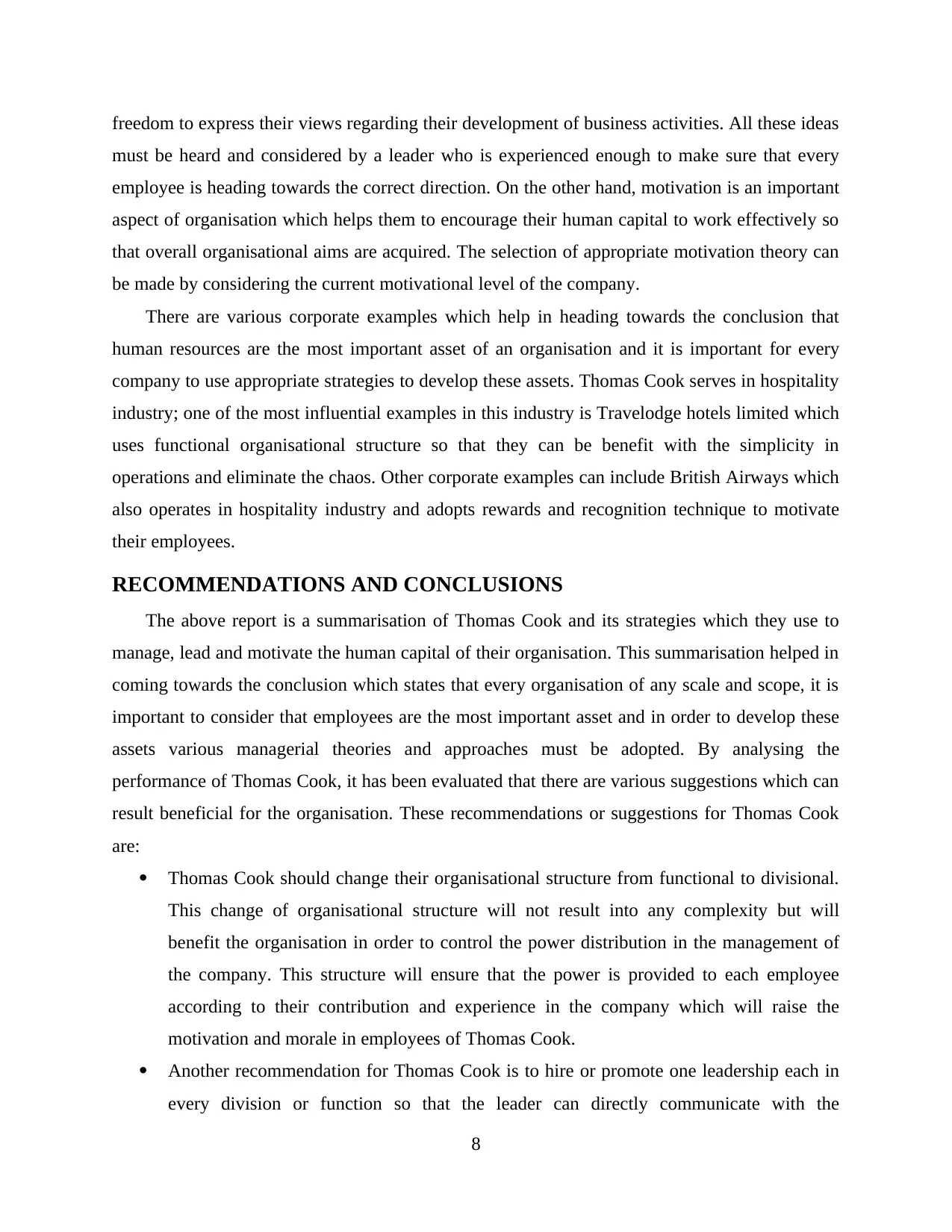
freedom to express their views regarding their development of business activities. All these ideas
must be heard and considered by a leader who is experienced enough to make sure that every
employee is heading towards the correct direction. On the other hand, motivation is an important
aspect of organisation which helps them to encourage their human capital to work effectively so
that overall organisational aims are acquired. The selection of appropriate motivation theory can
be made by considering the current motivational level of the company.
There are various corporate examples which help in heading towards the conclusion that
human resources are the most important asset of an organisation and it is important for every
company to use appropriate strategies to develop these assets. Thomas Cook serves in hospitality
industry; one of the most influential examples in this industry is Travelodge hotels limited which
uses functional organisational structure so that they can be benefit with the simplicity in
operations and eliminate the chaos. Other corporate examples can include British Airways which
also operates in hospitality industry and adopts rewards and recognition technique to motivate
their employees.
RECOMMENDATIONS AND CONCLUSIONS
The above report is a summarisation of Thomas Cook and its strategies which they use to
manage, lead and motivate the human capital of their organisation. This summarisation helped in
coming towards the conclusion which states that every organisation of any scale and scope, it is
important to consider that employees are the most important asset and in order to develop these
assets various managerial theories and approaches must be adopted. By analysing the
performance of Thomas Cook, it has been evaluated that there are various suggestions which can
result beneficial for the organisation. These recommendations or suggestions for Thomas Cook
are:
Thomas Cook should change their organisational structure from functional to divisional.
This change of organisational structure will not result into any complexity but will
benefit the organisation in order to control the power distribution in the management of
the company. This structure will ensure that the power is provided to each employee
according to their contribution and experience in the company which will raise the
motivation and morale in employees of Thomas Cook.
Another recommendation for Thomas Cook is to hire or promote one leadership each in
every division or function so that the leader can directly communicate with the
8
must be heard and considered by a leader who is experienced enough to make sure that every
employee is heading towards the correct direction. On the other hand, motivation is an important
aspect of organisation which helps them to encourage their human capital to work effectively so
that overall organisational aims are acquired. The selection of appropriate motivation theory can
be made by considering the current motivational level of the company.
There are various corporate examples which help in heading towards the conclusion that
human resources are the most important asset of an organisation and it is important for every
company to use appropriate strategies to develop these assets. Thomas Cook serves in hospitality
industry; one of the most influential examples in this industry is Travelodge hotels limited which
uses functional organisational structure so that they can be benefit with the simplicity in
operations and eliminate the chaos. Other corporate examples can include British Airways which
also operates in hospitality industry and adopts rewards and recognition technique to motivate
their employees.
RECOMMENDATIONS AND CONCLUSIONS
The above report is a summarisation of Thomas Cook and its strategies which they use to
manage, lead and motivate the human capital of their organisation. This summarisation helped in
coming towards the conclusion which states that every organisation of any scale and scope, it is
important to consider that employees are the most important asset and in order to develop these
assets various managerial theories and approaches must be adopted. By analysing the
performance of Thomas Cook, it has been evaluated that there are various suggestions which can
result beneficial for the organisation. These recommendations or suggestions for Thomas Cook
are:
Thomas Cook should change their organisational structure from functional to divisional.
This change of organisational structure will not result into any complexity but will
benefit the organisation in order to control the power distribution in the management of
the company. This structure will ensure that the power is provided to each employee
according to their contribution and experience in the company which will raise the
motivation and morale in employees of Thomas Cook.
Another recommendation for Thomas Cook is to hire or promote one leadership each in
every division or function so that the leader can directly communicate with the
8
Paraphrase This Document
Need a fresh take? Get an instant paraphrase of this document with our AI Paraphraser
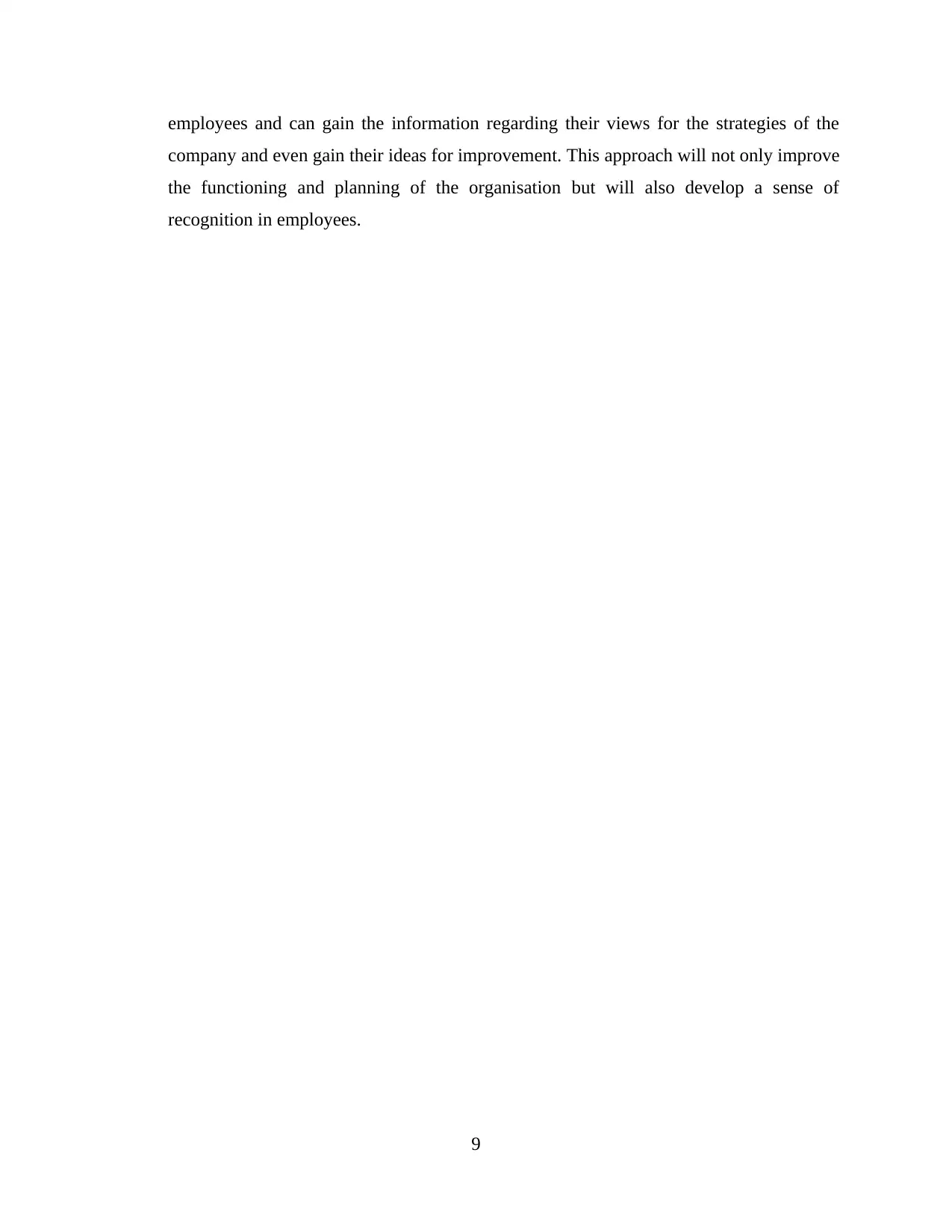
employees and can gain the information regarding their views for the strategies of the
company and even gain their ideas for improvement. This approach will not only improve
the functioning and planning of the organisation but will also develop a sense of
recognition in employees.
9
company and even gain their ideas for improvement. This approach will not only improve
the functioning and planning of the organisation but will also develop a sense of
recognition in employees.
9
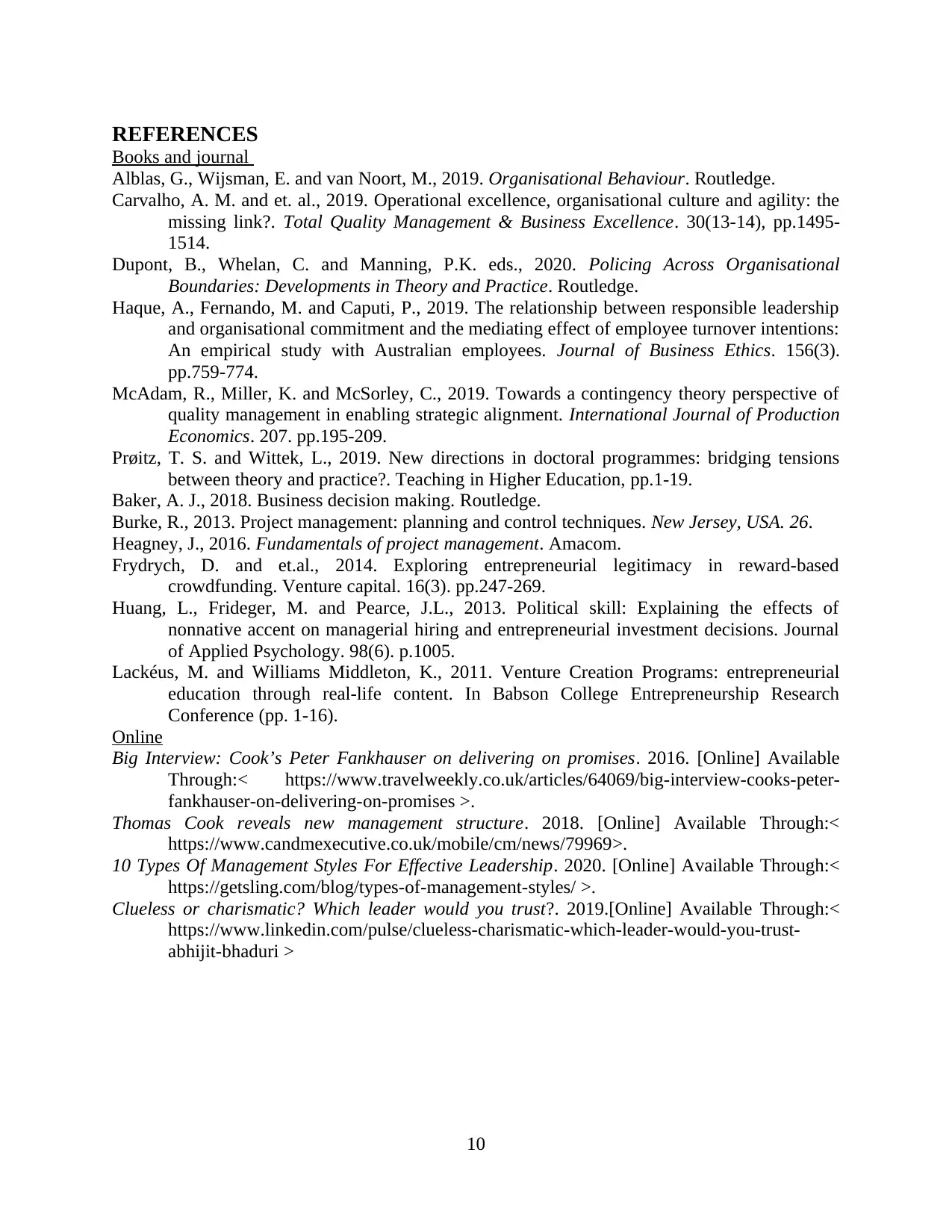
REFERENCES
Books and journal
Alblas, G., Wijsman, E. and van Noort, M., 2019. Organisational Behaviour. Routledge.
Carvalho, A. M. and et. al., 2019. Operational excellence, organisational culture and agility: the
missing link?. Total Quality Management & Business Excellence. 30(13-14), pp.1495-
1514.
Dupont, B., Whelan, C. and Manning, P.K. eds., 2020. Policing Across Organisational
Boundaries: Developments in Theory and Practice. Routledge.
Haque, A., Fernando, M. and Caputi, P., 2019. The relationship between responsible leadership
and organisational commitment and the mediating effect of employee turnover intentions:
An empirical study with Australian employees. Journal of Business Ethics. 156(3).
pp.759-774.
McAdam, R., Miller, K. and McSorley, C., 2019. Towards a contingency theory perspective of
quality management in enabling strategic alignment. International Journal of Production
Economics. 207. pp.195-209.
Prøitz, T. S. and Wittek, L., 2019. New directions in doctoral programmes: bridging tensions
between theory and practice?. Teaching in Higher Education, pp.1-19.
Baker, A. J., 2018. Business decision making. Routledge.
Burke, R., 2013. Project management: planning and control techniques. New Jersey, USA. 26.
Heagney, J., 2016. Fundamentals of project management. Amacom.
Frydrych, D. and et.al., 2014. Exploring entrepreneurial legitimacy in reward-based
crowdfunding. Venture capital. 16(3). pp.247-269.
Huang, L., Frideger, M. and Pearce, J.L., 2013. Political skill: Explaining the effects of
nonnative accent on managerial hiring and entrepreneurial investment decisions. Journal
of Applied Psychology. 98(6). p.1005.
Lackéus, M. and Williams Middleton, K., 2011. Venture Creation Programs: entrepreneurial
education through real-life content. In Babson College Entrepreneurship Research
Conference (pp. 1-16).
Online
Big Interview: Cook’s Peter Fankhauser on delivering on promises. 2016. [Online] Available
Through:< https://www.travelweekly.co.uk/articles/64069/big-interview-cooks-peter-
fankhauser-on-delivering-on-promises >.
Thomas Cook reveals new management structure. 2018. [Online] Available Through:<
https://www.candmexecutive.co.uk/mobile/cm/news/79969>.
10 Types Of Management Styles For Effective Leadership. 2020. [Online] Available Through:<
https://getsling.com/blog/types-of-management-styles/ >.
Clueless or charismatic? Which leader would you trust?. 2019.[Online] Available Through:<
https://www.linkedin.com/pulse/clueless-charismatic-which-leader-would-you-trust-
abhijit-bhaduri >
10
Books and journal
Alblas, G., Wijsman, E. and van Noort, M., 2019. Organisational Behaviour. Routledge.
Carvalho, A. M. and et. al., 2019. Operational excellence, organisational culture and agility: the
missing link?. Total Quality Management & Business Excellence. 30(13-14), pp.1495-
1514.
Dupont, B., Whelan, C. and Manning, P.K. eds., 2020. Policing Across Organisational
Boundaries: Developments in Theory and Practice. Routledge.
Haque, A., Fernando, M. and Caputi, P., 2019. The relationship between responsible leadership
and organisational commitment and the mediating effect of employee turnover intentions:
An empirical study with Australian employees. Journal of Business Ethics. 156(3).
pp.759-774.
McAdam, R., Miller, K. and McSorley, C., 2019. Towards a contingency theory perspective of
quality management in enabling strategic alignment. International Journal of Production
Economics. 207. pp.195-209.
Prøitz, T. S. and Wittek, L., 2019. New directions in doctoral programmes: bridging tensions
between theory and practice?. Teaching in Higher Education, pp.1-19.
Baker, A. J., 2018. Business decision making. Routledge.
Burke, R., 2013. Project management: planning and control techniques. New Jersey, USA. 26.
Heagney, J., 2016. Fundamentals of project management. Amacom.
Frydrych, D. and et.al., 2014. Exploring entrepreneurial legitimacy in reward-based
crowdfunding. Venture capital. 16(3). pp.247-269.
Huang, L., Frideger, M. and Pearce, J.L., 2013. Political skill: Explaining the effects of
nonnative accent on managerial hiring and entrepreneurial investment decisions. Journal
of Applied Psychology. 98(6). p.1005.
Lackéus, M. and Williams Middleton, K., 2011. Venture Creation Programs: entrepreneurial
education through real-life content. In Babson College Entrepreneurship Research
Conference (pp. 1-16).
Online
Big Interview: Cook’s Peter Fankhauser on delivering on promises. 2016. [Online] Available
Through:< https://www.travelweekly.co.uk/articles/64069/big-interview-cooks-peter-
fankhauser-on-delivering-on-promises >.
Thomas Cook reveals new management structure. 2018. [Online] Available Through:<
https://www.candmexecutive.co.uk/mobile/cm/news/79969>.
10 Types Of Management Styles For Effective Leadership. 2020. [Online] Available Through:<
https://getsling.com/blog/types-of-management-styles/ >.
Clueless or charismatic? Which leader would you trust?. 2019.[Online] Available Through:<
https://www.linkedin.com/pulse/clueless-charismatic-which-leader-would-you-trust-
abhijit-bhaduri >
10
⊘ This is a preview!⊘
Do you want full access?
Subscribe today to unlock all pages.

Trusted by 1+ million students worldwide
1 out of 12
Related Documents
Your All-in-One AI-Powered Toolkit for Academic Success.
+13062052269
info@desklib.com
Available 24*7 on WhatsApp / Email
![[object Object]](/_next/static/media/star-bottom.7253800d.svg)
Unlock your academic potential
Copyright © 2020–2025 A2Z Services. All Rights Reserved. Developed and managed by ZUCOL.




